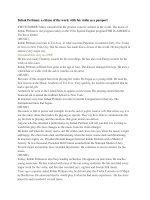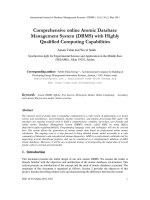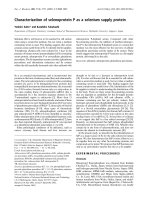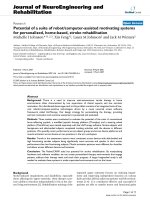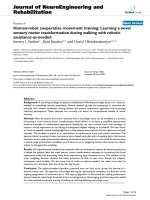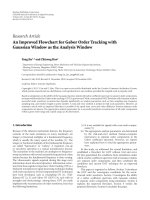Head disk system characterization with head itself as transducer
Bạn đang xem bản rút gọn của tài liệu. Xem và tải ngay bản đầy đủ của tài liệu tại đây (1.73 MB, 170 trang )
Head-Disk System Characterization with
Head Itself as Transducer
ZHOU YIPIN
NATIONAL UNIVERSITY OF SINGAPORE
2006
Head-Disk System Characterization with
Head Itself as Transducer
ZHOU YIPIN
A THESIS SUBMITTED
FOR THE DEGREE OF MASTER OF ENGINEERING
DEPARTMENT OF ELECTRICAL AND COMPUTER ENGINEERING
NATIONAL UNIVERSITY OF SINGAPORE
2006
Acknowledgments
There are many people who have made the completion of this dissertation and my
graduate studies possible. Firstly, I would like to express my most sincere appreciation
to all those who have helped me through this Master thesis. Many thank to my
supervisor Dr. Liu Bo for his offering me the opportunity to do research work in
magnetic recording, such an interesting and diverse field. His broad knowledge and
enthusiasm in this field inspires me in the research work; his keen observation and
strict research attitude contributed a great deal to the research work. I feel very
fortunate to have him as a research advisor. I also wish to thank my supervisor, Prof.
Li Lewei, for his kind support on my research course and allowing me to work under
him for the past two years.
I thank all the members of my research group and the faculty and students at Data
Storage Institute, Spinstronics, Media and Interface Division for useful technical
discussions over the years. Special thanks to Mr. Li Hui, Dr. Yuan Zhimin, Dr. Wan
Lei, Ms Zhang Wei, Mr. Ng Ka Wei, Dr. Zhang Mingsheng, Mr. Xian Rui, Miss Xiao
Peiying and Miss Zhu Jin for their warm assistance.
At last, I would like to thank my parents and family for their love, encouragement,
support and for their always being there to listen to me and offer advises. Without their
understanding, I would not have completed this Master thesis. Also thank people who
love me and people I love, thanks for those happy time in National University of
Singapore.
i
Table of Contents
ACKNOWLEDGMENTS ............................................................................................................... I
TABLE OF CONTENTS ................................................................................................................II
SUMMARY......................................................................................................................................V
NOMENCLATURE .....................................................................................................................VII
LIST OF FIGURES....................................................................................................................... IX
LIST OF TABLES ........................................................................................................................XII
CHAPTER 1 .....................................................................................................................................1
INTRODUCTION............................................................................................................................1
1.1 Magnetic Recording and Magnetic Hard Disk Drive .........................................................1
1.1.1 Magnetic Hard Disk Drives...............................................................................................1
1.1.2 Evolution of Magnetic Hard Disk Drive ...........................................................................2
1.1.3 Technology Trends and Challenges ...................................................................................3
1.2 Magnetic Head Disk Integration...........................................................................................5
1.2.1 Magnetic Reading Head ....................................................................................................5
1.2.2 Magnetic Writing Head .....................................................................................................7
1.2.3 Magnetic Integration of Head-Disk Systems.....................................................................7
1.3 Problem Statement and Motivations ....................................................................................9
1.3.1 Head-Disk System Characterization..................................................................................9
1.3.2 Simulation Platform Development for Head-Disk System .............................................10
1.3.3 Evaluation of Harmonic Based Fly-Height Measurement Method .................................11
1.3.4 Gap Length Variation Estimation Method.......................................................................12
1.3.5 High Density Recording and High Data Rate Recording................................................12
1.4 Contributions and Organization of the Thesis ..................................................................14
CHAPTER 2 ...................................................................................................................................16
FLY-HEIGHT MEASUREMENT ...............................................................................................16
2.1 Optical Fly-Height Testing Methods...................................................................................17
2.1.1 Three-Wavelength Intensity Interferometry Technique...................................................18
2.1.2 Limitations of the State-of-the-Art Optical Fly-Height Test Method ..............................20
2.2 In-Situ Fly-Height Testing Methods ...................................................................................22
2.2.1 Reading Process Based Methods.....................................................................................23
2.2.1.1 PW50 Method .............................................................................................................23
2.2.1.2 Harmonic Method .......................................................................................................25
2.2.1.3 Triple Harmonic Method ............................................................................................27
2.2.2 Writing Process Based Methods......................................................................................29
2.2.2.1 Carrier Erasure Current Method .................................................................................29
2.2.2.2 Scanning Carrier Current Method...............................................................................31
2.2.3 Capacitance Method ........................................................................................................32
2.3 Summary...............................................................................................................................34
CHAPTER 3 SIMULATION PLATFORM DEVELOPMENT ................................................35
3.1 Platform Development .........................................................................................................35
3.1.1 Motivation and Functions Developed..............................................................................35
3.1.2 User Interface ..................................................................................................................37
3.2 Transition Modeling and Playback Signal Modeling ........................................................39
3.2.1 Medium Transition Model of the Write Process..............................................................39
3.2.2 Reading Process Modeling and MR Head Reciprocity ...................................................41
ii
3.2.2.1 Reciprocity Algorithm ................................................................................................41
3.2.2.2 Surface Potential Model Comparison .........................................................................44
3.2.3 Playback Pulses ...............................................................................................................49
3.3 Playback with Multiple Transitions....................................................................................52
3.4 Spectral Analysis ..................................................................................................................56
3.4.1 Isolated Pulse Frequency Response.................................................................................56
3.4.2 Harmonic Ratio Methods and Spectrum Comparison .....................................................58
3.4.2.1 Square Wave Recording..............................................................................................59
3.4.2.2 Triple Harmonic Pattern Recording ............................................................................61
3.4.2.3 Energy Distribution of Harmonics..............................................................................63
3.5 Summary...............................................................................................................................65
CHAPTER 4 IN-DEPTH ANALYSIS OF HARMONIC RATIO BASED ..............................66
FLY-HEIGHT MEASUREMENT METHODS ..........................................................................66
4.1 Measurement Sensitivity......................................................................................................66
4.2 Measurement Precision........................................................................................................68
4.2.1 Repeatability Function.....................................................................................................69
4.2.2 Effect of Variation of System Parameters on Fly-Height Measurement..........................69
4.2.2.1 Media Thickness Effect ................................................................................................70
4.2.2.2 Gap Length Effect ........................................................................................................72
4.2.3 Effect of Noise on Fly-Height Measurement...................................................................73
4.2.3.1 Peak Detection and Testing Accuracy ..........................................................................75
4.2.3.2 Envelope Detection and Testing Accuracy ...................................................................77
4.3 Experiment Investigations...................................................................................................78
4.3.1 Experiments.....................................................................................................................78
4.3.2 Heads and Media Characterization..................................................................................81
4.3.3 Comparison of Theoretical and Experiment Waveforms.................................................84
4.3.4 Testing Repeatability .......................................................................................................86
4.3.4.1 Triple Harmonic Method ..............................................................................................86
4.3.4.2 Square Wave Method....................................................................................................90
4.4 Summary...............................................................................................................................92
CHAPTER 5 HARMONIC ANALYSIS METHOD, GAP LENGTH EFFECT AND
ESTIMATION OF GAP LENGTH DEVIATION ......................................................................93
5.1 Gap Length Effect on Fly-Height Measurement ...............................................................93
5.1.1 Experiment Design ..........................................................................................................93
5.1.2 Experimental Conditions and Nominal Head-Media Parameters....................................94
5.1.3 Experimental Results and Discussion..............................................................................95
5.1.4 Further Experimental Analysis and Phenomenon Confirmation .....................................98
5.1.5 Root Cause Identification ..............................................................................................101
5.1.6 Further Discussion on Gap Length Effect at Different Sensitivity Variation with Density
................................................................................................................................................103
5.2 Gap Length Variation Estimation.....................................................................................107
5.2.1 Motivation for Exploring New Methodology................................................................108
5.2.2 Theory of the Methodology...........................................................................................109
5.2.2.1 G Function and Gap Length Difference between Reference Head and Sample Head
..............................................................................................................................................110
5.2.2.2 Gap Length Variation Function and Gap Length Estimation....................................113
5.2.3 Experiment Results........................................................................................................115
5.3 Summary.............................................................................................................................119
CHAPTER 6 HIGH DENSITY RECORDING AND NONLINEARITY EFFECT ..............120
6.1. Performance Analysis at High Recording Density .........................................................120
6.2 Nonlinearity at High Bit Density and Its Effects on Accuracy of In-Situ Flying Height
Analysis .....................................................................................................................................124
6.2.1 Nonlinearity at High Linear Density Recording............................................................124
6.2.2 Interactions between NLTS and HTS ............................................................................125
iii
6.2.2.1 Transition Shift over AC Erased Track .....................................................................125
6.2.2.2 Transition Shift over DC Erased Track.....................................................................126
6.2.3 Effect on Triple Harmonic Pattern.................................................................................128
6.2.3.1 Transition Shift and All “1” Pattern ..........................................................................128
6.2.3.2 Transition Shift and Triple Harmonic Pattern ...........................................................128
6.2.4 Enforced Nonlinearity Effect at High Data Rate Recording .........................................129
6.3 Fly-Height Testing in High Linear Density and High Data Rate Recording.................132
6.4 Summary.............................................................................................................................136
CHAPTER 7 .................................................................................................................................138
NONLINEARITY IN TRACK DIRECTION AND ITS EFFECTS ON FLY-HEIGHT
ANALYSIS....................................................................................................................................138
7.1 Experiments in Track Direction........................................................................................138
7.1.1 Cross-track Profile.........................................................................................................138
7.1.2 Track-edge Effect at High Density ................................................................................141
7.2 Theory and Simulation ......................................................................................................143
7.2.1 Recording Physics Underlying the Phenomena.............................................................143
7.2.2 Simulation Model ..........................................................................................................145
7.3 Summary.............................................................................................................................148
CHAPTER 8 .................................................................................................................................149
SUMMARY AND FUTURE WORK..........................................................................................149
REFERENCES .............................................................................................................................152
iv
Summary
Areal density, or storage capacity, is the most critical parameters for a magnetic hard
disk drive (HDD). In order to achieve high density data recording, all parameters in
the head-disk systems of a magnetic disk drives have been scaled downwards
progressively to write/read smaller and smaller data bits. Therefore, how to accurately
and reliably characterize the critical parameters of head disk systems becomes
challenging and crucial for sustaining the growth of areal density of HDD.
Low fly-height head-disk interface technology, high sensitivity head technology and
small grain size media technology are 3 technologies determining the achievable area
density of a magnetic hard disk drive. To further increase the recording density, we
have to further reduce the fly-height (FH), which is the spacing between slider and
recording disk. Currently technology allows for 8-10 nm fly-height in high-end
commercial disk drives. The intermolecular force effect, slider-lube and slider-lubedisk interactions become the main concerns of head disk interface at such a small
spacing. However, the current industry standard fly-height measurement technology,
namely, the optical fly-height testing technology, can not be used to evaluate the
instability caused by such interaction, and in-situ characterization is the only
acceptable solution. Among various in-situ techniques, the technology that uses head
itself as transducer for the fly-height characterization is believed to be the best choice,
as it can well reflect the actual scenario in the disk drives and head-disk interface.
This dissertation focuses on characterization technology with data reading head as
transducer. A simulation platform is developed for modeling and simulation of the
magnetic interaction and inter-dependence of magnetic head and magnetic disk-media
v
-- the magnetic head-disk systems. The platform provides the flexibility of theoretical
model selection and parameters setup. It provides the convenience for the analysis of
the effects of read / writes parameters on the overall performance of readback signal.
The platform proved to be a powerful tool for the exploration and confirmation of
characterization methods
Thorough experimental and theoretical evaluations of harmonic ratio based fly-height
measurement methods are done based on testing sensitivity and accuracy. Sensitivity
function, error model and repeatability function are proposed in this thesis.
Furthermore, the methods and parameter selections to achieve high testing sensitivity
and accuracy are proposed and experimentally confirmed.
Gap length is the most important geometric parameter of the reading head. It defines
the resolution of the reading head. A novel method is proposed for the quantitative
evaluation of the gap length variation among a batch of magnetoresistive/giant
magnetoresistive (MR/GMR) heads with same structure and similar design. According
to literature review, no one has reported a method for the evaluation of gap length
difference among heads of same nominal gap length value yet. Experimental work
confirms that the proposed method is easy for implementation and the results suggest
that variation of gap length is considerable and may have obvious effect on recording
performance in high density recording systems.
Nonlinearity is another challenge when technology moves to high density. This thesis,
for the first time, reports the experimental investigation and theoretical explanation of
the possible in-situ testing error caused by nonlinearity effects at high recording
density.
vi
Nomenclature
Unless otherwise stated, the following abbreviations and symbols are used throughout
this dissertation.
ABS
Air Bearing Surface
AGC
Automatic Gain Controller
DFHT
Dynamic Fly Height Tester
DLC
Diamond Like Carbon
FFT
Fast Fourier Transform
FH
Fly Height
FIR
Finite Impulse Response
GMR
Giant Magnetoresistive
GPIB
General Purpose Interface Bus (IEEE 488)
HAMR
Heat Assisted Magnetic Recording
HDD
Hard Disk Drive
HF
High Frequency
HMS
Head Medium Spacing
HRF
Harmonic Ratio Fly-Height
HTS
Hard Transition Shift
IF
Intermediate Frequency
IIR
Infinite Impulse Response
LF
Low Frequency
MCU
Micro Controller Unit
MFM
Magnetic Force Microscope
vii
MR
Magnetoresistive
NLTS
Nonlinear Transition Shift
PLL
Phase-Locked Loop
PRML
Partial Response Maximum Likelihood
RPM
Revolution Per Minute
RWA
Read/Write Analyzer
SNR
Signal-to-Noise Ratio
SUL
Soft Under Layer
TAA
Track Average Amplitude
THM
Triple Harmonic Method
UP
Universal Preamplifier
WITE
Windows™ Integrated Test Environment (Guzik Enterprise)
viii
List of Figures
Chapter 1
Fig. 1.1 Hard disk drive structures..................................................................................2
Fig. 1.2 Scaling law of parameters with the increase in areal density ............................4
Fig. 1.3 Merged read/write head flying over the medium: (a) perpendicular, (b)
longitudinal ..............................................................................................................6
Fig. 1.4 Illustration of fly-height and magnetic spacing.................................................8
Chapter 2
Fig. 2.1 Schematic of three-wavelength fly-height tester .............................................18
Fig. 2.2 Multi- reflections and transmissions for two interfaces ..................................19
Fig. 2.3 Sensitivity of the optical fly-height test method..............................................21
Fig. 2.4 The formation of the “111100” code pattern ...................................................28
Chapter 3
Fig. 3.1 User interface of simulation platform..............................................................37
Fig. 3.2 Data flow diagram ...........................................................................................38
Fig. 3.3 Transition shapes of mostly used functions and micro magnetic model .........40
Fig. 3.4 Geometrical configuration of modeling of reading process ............................44
Fig. 3.5 Surface potential Φ s (x ) with different approaches ..........................................45
Fig. 3.6 (a) Surface head field with t/g=1/10 (b) Surface head field with t/g=1/5 ....45
Fig. 3.7 Comparison between Potter and Fourier surface field spectra ........................48
Fig. 3.8 Voltage pulse with different transition models, showing that tanh and error
function models give similar amplitude.................................................................50
Fig. 3.9 Voltage pulse with different surface potential models.....................................50
Fig. 3.10 Voltage Pulse with different magnetic spacing d...........................................51
Fig. 3.11 Square wave recording playback signal with B=400nm ...............................53
Fig. 3.12 Square wave recording playback signal with B=120nm ...............................53
Fig. 3.13 Roll off curves of different magnetic spacing ...............................................54
Fig. 3.14 Roll off curves of different gap length ..........................................................55
Fig. 3.15 111100-code playback signals .......................................................................56
Fig. 3.16 Square wave spectrum of the fundamental component .................................60
Fig. 3.17 Square Wave voltage spectrums ....................................................................61
Fig. 3.18 spectrum of readback signal of “111100” pattern.........................................63
Fig. 3.19 Normalized Harmonic Power of the conventional square wave recording ...64
Fig. 3.20 Power Spectrum of the triple harmonic method............................................64
Chapter 4
Fig. 4.1 Harmonic intensity at different channel density..............................................67
Fig. 4.2 Media thickness effect on fly-height measurement.........................................71
Fig. 4.3 Gap length variation effect on fly-height measurement ..................................73
Fig. 4.4 Harmonic Power and fly-height error caused by transition noise and channel
noise .......................................................................................................................76
ix
Fig. 4.5 Fly-height error caused by transition noise and channel noise........................76
Fig. 4.6 Block diagram of the programmable filters for the in-situ fly-height test.......77
Fig. 4.7 Block diagram of the experimental configuration...........................................79
Fig. 4.8 Experimental setup for harmonic based in-situ fly-height and gap width
measurement ..........................................................................................................81
Fig. 4.9 ABS design (a) 2-D image and (b) 3-D image of the slider used in the
experiment .............................................................................................................82
Fig. 4.10 Track average voltages; overwrite ratio and PW50 as a function of write
current ....................................................................................................................83
Fig. 4.11 MR saturation curves.....................................................................................84
Fig. 4.12 Roll-off curve ................................................................................................84
Fig. 4.13 (a) Experiment waveform at density 1.32 (b) Simulation waveform at
density1.32.............................................................................................................85
Fig. 4.14 Comparison between A/B of experiment and simulation waveforms at
multiple densities ...................................................................................................86
Fig. 4.15 Maximum fly-height variation (nm) with different harmonic ratios and
densities .................................................................................................................88
Fig. 4.16 Average fly-height variation (nm) with different harmonic ratios and
densities .................................................................................................................89
Fig. 4.17 Simulated fly-height variation with different harmonic ratios and densities 90
Fig. 4.18 Average and maximum fly-height variation (nm) of all one pattern at
different densities...................................................................................................91
Fig. 4.19 Simulated fly-height variation of all one pattern at different density............92
Chapter 5
Fig. 5.1 Fly-height variation ΔFH of 130 heads calculated at different testing densities
...............................................................................................................................97
Fig. 5.2 Δ( FH + ln C ) of 43 heads calculated at different densities.............................99
Fig. 5.3 Δ( FH + ln C ) (nm) variation at different channel densities of different media
thickness (nominal gap length δ 0 = 20nm )..........................................................102
Fig. 5.4 ΔFH + ln C (nm) variation at different channel densities and different gap
lengths (nominal gap length g 0 = 36nm ).............................................................103
Fig. 5.5 (a) Δ ln C variation ΔΔ ln C of 43 heads calculated at densities 0.354 and 0.708
.............................................................................................................................104
Fig. 5.6 (a) Δ ln C variation ΔΔ ln C of 43 heads calculated at densities 0.354 and 0.566
.............................................................................................................................106
Fig. 5.7 (a) Structure and (b) geometrical scheme for the evaluation of gap length
variation of typical spin valve reading head ........................................................108
Fig. 5.8 Dependence of the function G on channel density and gap length variation 112
Fig. 5.9 Dependence of the function G on gap length variation at three densities ..... 112
Fig. 5.10 GL function and its dependence on channel density ................................... 113
Fig. 5.11 Experimental gap length variation function for Densities 0.708 and 1.415 116
Fig. 5.12 Estimated gap length for densities 0.708 and 1.415 .................................... 117
Fig. 5.13 Experimental gap length variation function for Densities 0.566 and 1.415 117
Fig. 5.14 Estimated gap length for densities 0.566 and 1.415 .................................... 117
Fig. 5.15 Comparison of cumulative curves of estimated gap length at different density
combinations (densityies 0.566 and 1.415, densities 0.708 and 1.415)............... 119
x
Chapter 6
Fig. 6.1 Frequency response of the readback channel ................................................121
Fig. 6.2 Effective magnetic spacing change (nm) without compensation of channel
response ...............................................................................................................123
Fig. 6.3 Effective spacing change (nm) with compensation of channel response ......123
Fig. 6.4 Measured transition shift for MR head with different initial medium
magnetization.......................................................................................................127
Fig. 6.5 Waveform with different erasing methods and linear superposition .............129
Fig. 6.6 NLTS as a function of linear recording density at various medium velocities
.............................................................................................................................130
Fig. 6.7 Harmonic Power (dB) of V3 and V1 tested at 6000 RPM with different erasing
methods ................................................................................................................134
Fig. 6.8 Harmonic ratios with different DC erase methods at 8000RPM...................134
Fig. 6.9 Harmonic ratios with different DC erase methods at 6000RPM...................135
Fig. 6.10 Differences in the harmonic ratio between the two erase methods at two disk
speeds...................................................................................................................136
Chapter 7
Fig. 7.1 ABS design (a) optical microscope image and (b) ZYGO microscope image
.............................................................................................................................139
Fig. 7.2 Harmonic ratio cross-track profile and the signal amplitude cross-track profile.
.............................................................................................................................140
Fig. 7.3 Cross-track profile of the different harmonic densities ...............................140
Fig. 7.4 Waveforms of triple harmonic method at 90Mhz (left) and 120Mhz (right) 141
Fig. 7.5 Change in effective magnetic spacing(nm) compared to track center as a
function of cross-track position ...........................................................................142
Fig. 7.6 Isolated pulse waveforms at track center and off-track positions .................143
Fig. 7.7 Constant write field magnitude contours and in-plane vector field .............144
Fig. 7.8 MFM measurements of transitions and transition contour curve ..................144
Fig. 7.9. Magnetization simulated with micro-magnetic model ................................146
Fig. 7.10. Assumed transition contour and transition parameter variation in the .......148
xi
List of Tables
Chapter 3
Table 3.1 Transition models used in the modeling platform.........................................40
Chapter 4
Table 4.1 Effect of media thickness variation on fly-height measurement...................72
Table 4.2 Head, media, and testing system parameters ................................................85
Table 4.3 Transition Parameter for Fitting....................................................................86
Table 4.4 Fly-height variation calculated with V21 of triple harmonic method............87
Table 4.5 Fly-height variation calculated with V31 of triple harmonic method............88
Table 4.6 Fly-height variation calculated with V32 of triple harmonic method............88
Table 4.7 Fly-height variation calculated with V31 of all one pattern at different
densities .................................................................................................................91
Chapter 5
Table 5.1 The value and rank of FH + ln C of 43 heads at different densities ...........101
Table 5.2 Theoretical gap length variation function for densities 0.708 and 1.415.... 116
Table 5.3 Theoretical gap length variation function for densities 0.566 and 1.415.... 118
Chapter 6
Table 6.1 The writing frequency (MHz) at different RPM for certain linear density.122
Table 6.2 Illustration of nonlinearity effect on pattern 111100 with different erasing
methods ................................................................................................................129
xii
Chapter 1
Introduction
Information technology plays an important role in our daily life. Information
technology includes information sensing technology, information transferring
technology (communication and network), and information storage technology.
Magnetic data storage technology continues to be the primary storage technology in
modern society.
The success of HDDs originates from an ever-increasing storage areal density, high
data rate and fast access time coupled with a consistent reduction in price per
megabyte enabled by continuous technological advances in recording physics, new
materials, mechanics, tribology, signal processing, and so on.
This thesis summarizes author’s efforts in investigating new testing methodologies and
their engineering solutions for high density magnetic data recording.
1.1 Magnetic Recording and Magnetic Hard Disk Drive
1.1.1 Magnetic Hard Disk Drives
A magnetic HDD consists of a disk pack, a set of read/write heads, sliders and
suspensions, actuation mechanisms and electronics as shown in Fig. 1.1. The
information is written onto co-rotating disks by a read/write head that is carried by a
1
slider located at the end of a suspension which is mounted on a rotary actuator. These
slider-suspension systems are stacked in an assembly called head stack. The
combination of the spinning disks and the rotary voice coil motor allows the read/write
transducers to rapidly scan the entire disk surface. The air pressure generated by the
spinning disk makes slider fly. The head is held off the disk surface by an air cushion,
or air bearing. The characteristics of the air bearing have a direct relationship with the
aerodynamic design of the slider. As the head is “floated” over the surface of high
speed moving disk, the concept of “fly-height” is introduced which refers to the
mechanical spacing between the read/write head and the disk surface.
Fig. 1.1 Hard disk drive structures
1.1.2 Evolution of Magnetic Hard Disk Drive
To meet the tremendous demand of data storage, the recording density of the HDDs
has to be increased continuously. Areal density of HDDs, measured in data bits per
square inch, is the primary indicator of technological progress in the HDD industry.
Areal density is the product of the number of tracks per inch (the track density) and the
number of bit per inch (the bit density). From the first hard disk drive introduced by
IBM in 1956 with an areal density of 2 kilo-bit (kb)/in2 and a storage capability of 5
2
mega-byte (MB) which had 50 disks and each disk being 24 inches in diameter of, to
the modern disk drives of areal density of more than 100 Gb/in2 and in various disk
diameters (called form-factor) from 5.25 inch to 1 inch, the areal density of HDDs has
been increasing tremendously in the last three decades. With the introduction of
magnetoresistive (MR) head, giant magnetoresistive (GMR) head and granular media
technology, the annual growth rate reaches to an amazing rate of 100% per year in the
recent past years (2001-2004). The magnetic properties, such as signal to noise ratio
(SNR), media coercivity and head structure, are also improved to keep in pace with the
increase of areal density.
The next goal of magnetic data storage technology is to increase the areal density to 1
TB/in2 in 3~5 years [1].
1.1.3 Technology Trends and Challenges
The general trend of magnetic recording and HDD technology is to further increase
areal density, further reduce the cost of each mega-byte of information stored in HDD
and retain high reliability. To achieve these objectives, all the parameters of the
magnetic recording system must be scaled downwards progressively. This is called the
scaling law. Fig. 1.2 illustrates the scaling down of head disk interface parameters with
increase in areal density.
Bit area, which is defined as the product of bit length and track pitch, needs to be
reduced in order to store more magnetic transitions in a unit area of disk surface.
Reading and writing heads are made in smaller size and the slider is designed to fly
3
closer to disk to maintain high read/write resolution while sensing a weaker magnetic
flux from the smaller bit area. Ideally, zero spacing is preferred. However, zero
spacing is impossible as it is impossible to achieve zero surface roughness on slider or
disk surface. Also, contact recording would lead to higher friction and wear at the
head-disk interface, hence causing reliability concerns and contact induced off-track
and vibration. At the same time, media thickness is required to be scaled down to
improve the read/write performance of the head-disk systems for high density data
storage. The ability to accurately and reliably characterize the critical parameters of
the head-disk systems, including fly-height, head parameters, and disk parameters,
becomes challenging and important for sustaining the growth of areal density in HDD.
Fig. 1.2 Scaling law of parameters with the increase in areal density
High sensitivity head transducer technology, highly stable data storage media with
further reduced grain size and grain size distribution, and further reduced but stable
head-disk spacing or fly-height are the major challenges for future magnetic data
storage industry.
4
As bit area decreases to some extend, the thermal energy in each data bit starts to
compete with the media anisotropy energy which maintains the stability of the bit,
causing magnetic instability problem. This behavior is called superparamagnetism and
can limit the future extendibility of magnetic storage. Although proper selection of
disk materials and structures can significantly delay the superparamagnetic effect, the
conventional longitudinal magnetic recording in continuous magnetic films may not be
able to push areal density beyond 200 Giga-bit (Gb)/in2 where limits of thermal
stability of magnetic bits exist. Perpendicular recording technology, with
magnetization of each bit orientated perpendicular to disk surface, will be used to push
recording density beyond 200 Gb/in2. However, writing capability will become a
limitation factor when areal density is further increase to a level beyond 1 Tera-bit
(Tb)/in2. It is expected that assisted writing scheme will be needed and one of the
promising assisted writing scheme is so called Heat Assisted Magnetic Recording
(HAMR) [1]. It is believed that pattern media, self-organized magnetic array and
assisted writing technology will make 50 Tb/in2 possible from magnetic view point.
However, it is widely believed that the engineering limitation of future high density
data storage comes from head-disk interface – how to achieve stable head-disk spacing
over nanometer spaced head-disk systems.
1.2 Magnetic Head Disk Integration
1.2.1 Magnetic Reading Head
Fig. 1.3 depicts a merged read/write head flying over a rotating disk where the
structure on the right illustrates the case for the longitudinal recording scheme and that
5
on the left illustrates the perpendicular recording. The head design consists of a thin
film inductive write element and a read element, which consists of a MR or GMR
sensor between two magnetic shields.
The magnetic shields are made of soft, highly permeable magnetic material. Thus, the
MR or GMR sensor essentially "sees" only the magnetic field from the recorded data
bit to be read. In a merged read/write head structure, the second magnetic shield also
functions as one pole of the inductive write head.
(a)
(b)
Fig. 1.3 Merged read/write head flying over the medium: (a) perpendicular, (b) longitudinal
During reading, the presence of a magnetic transition or flux reversal between bits
causes the magnetic orientation in the MR or GMR sensor to change and this causes
the resistance of this sensor to change. The sensor's output voltage or signal is the
product of this resistance change and the read bias current. The resistance change
signal is amplified by low-noise electronics and sent to the HDD's data detection
electronics. In general, MR devices are complex structures that incorporate many
magnetic layers to achieve linearity with respect to the external field.
6
1.2.2 Magnetic Writing Head
The inductive write head records bits of information by magnetizing tiny regions along
concentric tracks. To record information on the surface of the magnetic disk, an
alternating current is passed through the coils wrapped around a specially shaped
ferrous core in the write head, thus producing a fringing magnetic field in two
orientations. The magnetic fringing field in turn creates two permanently magnetized
states of remanent magnetization in the ferromagnetic data recording layer.
In the case of perpendicular magnetic recording scheme, the write field also creates
two states of remanent magnetization in the ferromagnetic layer: permanently
magnetized in either up or down direction perpendicular to the disk surface. There is a
special layer in the perpendicular magnetic recording media: the soft magnetic under
layer (SUL). The SUL is located under the data recording layer and it guides the
magnetic flux from the write pole to the collector pole and functions as part of the
write head. In simple models, it is often assumed that the SUL generates a mirror
image of the write pole, therefore effectively placing the recording media in the ‘gap’
of the ‘write head’.
1.2.3 Magnetic Integration of Head-Disk Systems
Maintaining a controlled separation between the magnetic recording head and the
magnetic medium is critically important for keeping reliable operation of HDDs.
Increase of areal density requires decreasing magnetic spacing between the head and
disk, which involves the head flying closer to the disk, as well as using a thinner
protective overcoat while maintaining a highly durable interface. The interaction
7
between slider, lubricant and disk surface is becoming the most crucial robustness
concern in advanced data storage systems. In general, Fig. 1.4 defines magnetic
spacing and fly-height, which are discussed in the thesis.
1. Fly-height: It is the distance from the air-bearing surface (ABS) to the mean
disk surface.
2. Head-Media Spacing (HMS): It is defined as the spacing between top of the
magnetic layer and bottom of the read/write element. It is the physical spacing
between magnetic head element and magnetic data recording layer. HMS includes
such factors as fly-height of the head over the disk, recession of the head pole tip,
and thickness of the diamond like carbon (DLC) film on the head surface and the
thickness of the carbon and lubricant overcoats on the disk surface.
3. Effective magnetic spacing: It is the effective spacing from data read/write
viewpoint. For longitudinal magnetic recording, it is the spacing between head
surface and half of the thickness of magnetic layer of the data recording disk.
Fig. 1.4 Illustration of fly-height and magnetic spacing
Current technology allows 7-10 nm fly-height in the high-end commercial disk drives.
It is estimated that the fly-height should be reduced to a value around 3.5-2.5 nm so as
8
to achieve areal densities around 1 Tb/in2. Since the head-disk spacing becomes so
small, intermittent contacts occur during disk drive operation. Such contacts lead to
fly-height variations.
Therefore, it becomes more and more important and necessary to make high accuracy
head-disk spacing measurement. Challenges arise in the effective and precise
characterization of head-disk system as the various system parameters are scaled down
to meet the requirements of growing areal density in disk drives.
1.3 Problem Statement and Motivations
1.3.1 Head-Disk System Characterization
All the parameters in head-disk systems have been scaled downwards progressively to
write/read smaller and smaller data bits. The smaller system dimension inevitably
introduces tribological and magnetic instabilities and makes the manufacturing process
more difficult to maintain the high standard of reliability and performance for the head
disk system. Furthermore, the ability to accurately and reliably characterize the critical
parameters of head-disk systems also becomes challenging and important for
sustaining the growth of areal density in HDD.
As in Fig. 1.2, head-disk spacing becomes very small. Since frequent intermittent or
continuous contacts occur during normal steady state operation in disk drives, the
slider-lube and slider-lube-disk interactions become the main concerns of head-disk
interface at such small spacing. Unfortunately, those commercial optical fly-height
9
testers, for instance, the Phase Matrices testers, use the special glass disks without the
carbon overcoat and lubricant layer to test fly-height, which clearly cannot identify the
problems related to lubricant. Furthermore, the normal optical apparatuses have no
means to access the operating conditions inside the actual disk drives and cannot
detect the gradual avalanche effect of head-disk crash and could not reflect the real
time fly-height modulation. In addition, the tester delivers poor repeatability for small
fly-heights of 5-6 nm in practice.
The in-situ characterization of head-disk spacing provides an alternative approach to
solve the shortcomings of the conventional optical methods. In magnetic recording,
‘in-situ’ refers to the method that the readback signals that are directly from the
preamplifier output and preceding the equalization channel are directly utilized to
obtain the useful information about the head-disk system. In-situ characterizations of
the head-disk system can reflect the actual scenario in the disk drives since no other
medium is introduced to carry the wanted information except the magnetic flux.
Among the various in-situ fly-height measurement methods, the most promising one is
the triple harmonic method based on the variation of the IBM’s harmonic ratio flyheight method (HRF)[2].
1.3.2 Simulation Platform Development for Head-Disk System
The motivation of simulation platform development is to provide a virtual design and
evaluation environment to promote the understanding of the complicated head-disk
systems and to explore new methodologies. The platform could be a powerful tool to
study the readback signal based head-disk system characterization methods with
flexibility of theory model selection and parameters setup.
10
The triple harmonic method is based on harmonic ratio of readback signal of MR
sensor in the present technology. In-depth analysis of the accuracy and resolution of
this method requires accurate mathematical modeling of the readback signal with MR
head as a transducer. But unfortunately, so far this method has only been studied based
on simple equations and its unique characteristics in engineering applications have not
been given enough theoretical support. Direct calculation of the flux is very
complicated, but with the reciprocity principle which utilizes the fact that the playback
process involves the mutual induction between the magnetic media and playback head,
we could study the readback signal characteristics with the information obtained from
the medium transition and the head potential function. There exist several
mathematical models for describing the medium transition and the head potential
characteristics with different levels of calculation complexity; both the accuracy and
calculation complexity should be considered and compromised in the modeling work.
Since readback signal with MR transducer has some unique characteristics compared
with that of inductive head, discussion should be focused on the reason and
consequences induced by these unique characteristics. The information gotten in time
domain signal and in frequency domain could help us in characterizing head medium
interface and should be analyzed. But special attention should be on characteristics in
frequency domain since the harmonic ratio of the read back signal is of our interest in
this method.
1.3.3 Evaluation of Harmonic Based Fly-Height Measurement
Method
The measurement errors of harmonic ratio fly-height methods in experiment deserve
exploration. Both testing sensitivity and accuracy should be considered as the criteria
11

